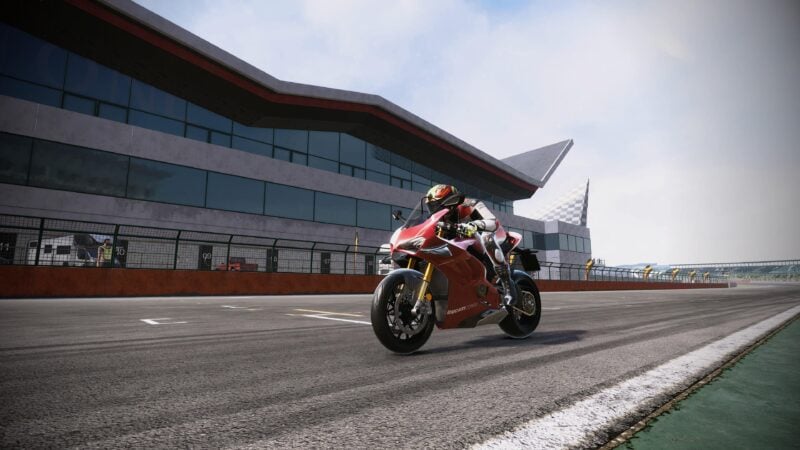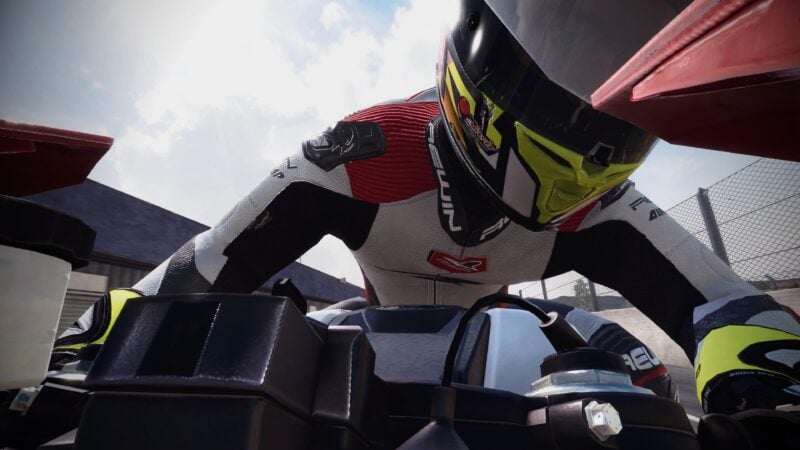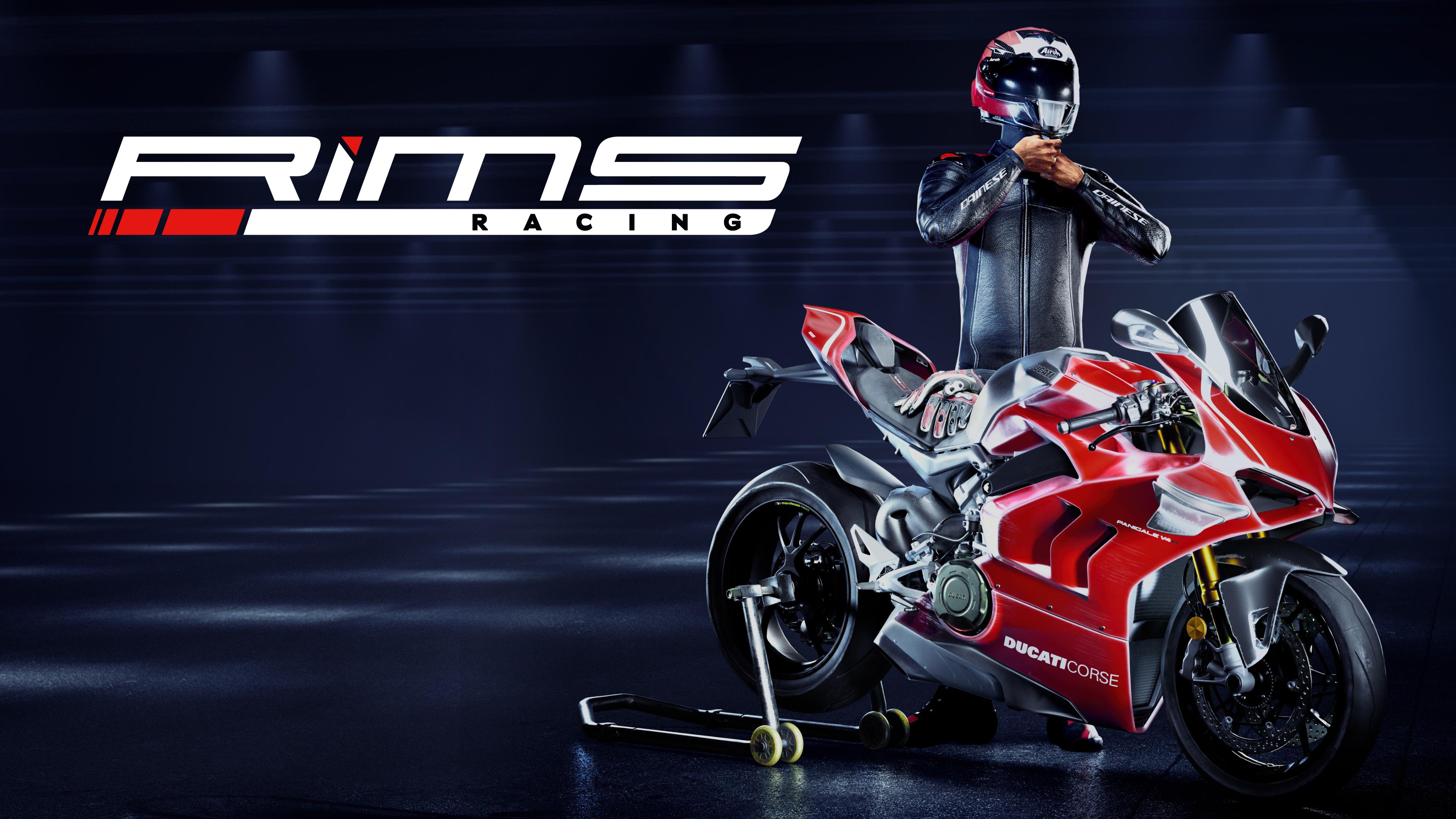
The world of racing simulation is pretty well-served for four-wheeled action. In fact anything from four wheels and up gets plenty of attention, given all the bus, truck, and farm vehicle simulators out there.
Start taking wheels away though and the market dwindles somewhat. Sure, there are yearly releases of racing bike games, but other than the occasional appearance of a Ride title, or the odd game set at the Isle of Man TT, you don’t really see all that many attempts at a Gran Turismo of Forza of bikes: buying and riding a selection of bikes, and modifying them to go really, really fast.
This is where RiMS Racing steps in. Created by RaceWard, an Italian studio which counts several ex-employees of Milestone – the studio behind bike titles like Ride, MotoGP, SBK – it’s intended to immerse the player into the world of motorbikes. That includes not only the chance to ride some of the best bikes in the world, but to go into the full ownership experience; the name itself is short for Rider and Motorbike Simulator.
Released today across both current console generations and PC, we’ve been taking RiMS Racing for a test-ride to see how it stacks up.

Content and Value For Money
The hyper-focused nature of RiMS really hurts its score here. RiMS has eight motorbikes and 14 tracks – 19 if you include riding the five road tracks backwards. Irritatingly, there is an additional circuit available as paid DLC at launch.
There’s certainly a good reason behind the choices, and it’s why the game has an average score here, but if you simply sit down and read the game box it’s a hard sell.
The point of the game isn’t to simulate as many bikes as it can, but to replicate the ownership experience of one — or more — of the best road bikes in the world right now. You can’t argue with the choices either, with a selection of 190hp+ superbikes from Aprilia, BMW, Ducati, Honda, Kawasaki, MV Agusta, Suzuki, and Yamaha representing the cream of the crop.
But it’s not simply a case of buy, ride, and then move onto the next one – although you can do that in the arcade-mode “Private Testing”. With the exception of the engine itself, you can customize the bike with hundreds of different components across every area.
That’s actually a crucial aspect of motorbike ownership; aside from the occasional vehicle kept original for collectorship purposes, bikes are rarely factory stock — and they’re a highly personal thing. More than that, the mods you might make to ride a track day at Silverstone aren’t necessarily the same ones you would for a blast up (or down) the San Marco Pass.
Somewhat disappointingly though, this feature operates through quicktime events. Players must physically unfasten screws, unmount components, select replacement items, remount them, and then screw them into place, all with the specific on-screen button requirements. Remember: righty-tighty, lefty-loosey.

The “Rider” part of the title comes into play too, as your avatar — which you can select as either male or female, but nothing more in-depth — is as customizable as the bike. There’s hundreds of clothing items, from suits to boots. Fortunately you don’t have to twirl the controller to undress your rider and equip new clothing…
However, both bike parts and dress items are locked behind game progress and in-game currency. You’ll need to get pretty far in the game to unlock some of the juicier performance items.
One crucially absent piece of the puzzle though is a livery editor. Although the bikes and clothing items can come in a number of different colors and designs, there’s no way to customize them any further. No decals, no editable patterns, and not even any option to just paint your bike purple. That might have been worth an extra star.
A much-vaunted feature before launch was the MSC, or Motorbike Status Check. This allows you to freeze the bike in motion at any point and observe the current state of any component, from current wear to various physical parameters like temperature and pressure. It’s a pretty decent teaching tool to learn how bits of bike react to certain inputs but again, some parts of MSC are locked behind game progress.

Online Features
Ultimately, RiMS Racing packs in pretty much the expected minimum of online functionality, but nothing more.
There’s two main areas for multiplayer. Players can choose “Online Challenges”, which are solo timed events that give “Fame Points” towards an online leaderboard and some other rewards (we’re not sure what, as trying to check on this resulted in the event being “terminated”). There’s also “Online Custom Events”, which allow you to create or join other people’s lobbies, in both single race and championship (cup) format.
One final multiplayer mode is “Offline Duel”, where two players can race locally in split-screen.
That means that there’s no facility for any ranked online multiplayer and certainly no ambition towards esports. The latter item isn’t a surprise, but given the existence of a “RiMS Card” – an online overview of all of your progress – it’s very odd that there’s nothing beyond the solo event “fame points” that contribute towards an online ranking of any kind.

Driving Physics and Handling
RiMS Racing is hard, but authentically so. Motorbikes are basically an affront to physics and simply shouldn’t function — the motorized version of the bumble bee. Everything is fighting against them at all times, as they try to put a stupid amount of power through a patch of rubber the size of a fruit roll-up without flipping over backwards, sliding away from underneath you, or any number of other entirely reasonable outcomes other than going quickly around a track.
Needless to say, we wrecked a perfectly good Yamaha R1 by low-siding it three times in the first two corners in the tutorial at Circuit Zolder (and let’s be fair, that’s not a great location to learn how to ride a 200hp bike for the first time) – even with everything set to easy…
However it didn’t take too long to get into a groove and crash less, but you will likely crash a lot. The bikes are very sensitive machines and you don’t have an axle that keeps one tire on the floor when the other is in the air; hit a kerb too hard and you’re gone. Lean too far without sufficient speed to generate a gyroscopic effect and you’re gone. Brake too hard and… you get the idea.
That said, we do have a couple of gripes. The major one regards the default controls, which place the brakes on the left trigger and the throttle on the right. This doesn’t sound like much of a problem, but motorbikes don’t activate their brakes all at once like a car; you have independent front and rear braking, and the rear brake is vital.
With the rear brake located on a face button there’s no analog control at all, which you need to balance the bike under heavy straight line braking or to get a little extra rotation in with a cheeky slide. Weirdly it remains digital — either coming on or letting off, but no fine control — even when remapped to a trigger where it should be (which really should be right for front, left for rear, and throttle on the right thumbstick), and it doesn’t use the DualSense’s adaptive features as a result. Also if you remap the controls as we did above, the Photomode features don’t work any more.
The other concerns rider movement. You can customize how your rider moves on the bike, leaning with their shoulders first (a classic road-riding technique), or shuffling their entire body to the point of being entirely out of the seat as you’ll see with racers. In this latter mode the rider takes an age to change direction, recentering himself (or herself) onto the seat before moving the other way, making chicanes — of which Zolder has many — painfully slow.
It’s also worth noting here that the AI are dreadful, at least at the lower difficulty levels. The riders have barely any awareness of each other, much less the player, and being rammed in a braking zone isn’t a rare occurrence — which is odd as they seem to panic brake everywhere, including when they do notice you alongside them.
All that said, ultimately it’s pretty satisfying to get it all right though — even if the ragdoll physics when you get it wrong are more like being clubbed by a Skyrim giant than a pro rider falling off.

Graphics
The best we can say about RiMS is that it looks okay — and that’s from playing on the PlayStation 5.
First the good: the bikes. The machines themselves are all very impressively captured and recreated in the game, and they look absolutely authentic. Given that each component is individually modeled, in order to allow for the core mechanic of interchangeability, that shouldn’t be a surprise.
Your base of operations is a lovingly recreated environment too, and reminiscent of the facility in sibling studio KT Racing’s WRC titles.
However the tracks themselves don’t appear to be up to the same high standards. There’s a certain… something about the lighting which feels a little off in just about all circumstances — usually either washed out, or too overcast, regardless of weather conditions — and none of them really pop.
Pop-in on the other hand, is something they all do. It’s pretty obvious right from the first time you leave the pits in the tutorial at Zolder, and the barrier verticals sequentially blink into existence just ahead of you, and you’ll spot it everywhere, from ad boards to flags in the crowd.
Clearly some effort has gone into making the circuits more dynamic than usual offerings, but there’s only so many times you can ride through the same patch of floating leaves at Laguna Seca before concluding that Monterey is experiencing some bizarre meteorological conditions
Although we’re not able to directly test, RiMS Racing doesn’t appear to run at 60fps on PS5, and we have experienced some further frame dropping at times — particularly on the object-dense road courses.

Sound Design
Generally speaking, the sound on RiMS is pretty decent, again with the focus being on the bikes themselves. One of the game’s developer diaries looked at how the RaceWard team captured audio from the motorbikes and the result speaks for itself.
The various bikes all sound just as they should, rather than variations on a theme, from the very hoarse MV Agusta and screaming Ninja to the thumping Panigale. How they sound very much depends on what your chosen camera angle is — a tight chase is different to a loose chase, and very different to the helmet cam. It’s all very audibly appealing, especially when you head through a tunnel.
Although perhaps not to everyone’s tastes, the EDM soundtrack from The Bloody Beetroots is suitably frantic — maybe not the most calming when you’re trying to learn how to ride a superbike, but certainly theme-appropriate.
There are weaker areas however, and they come in the form of crashes, tire noise, and ambient sound.
Dropping your bike, as you will do regularly at first, sounds rather like someone punching air conditioning ducting and is among the leading candidates for the loudest sound ever made. Meanwhile the tire squeal noise is more akin to the sound basketball shoes make as you squeak around a court.
Ambient noise is at least part of the mix, but in the events we’ve tried it seems to consist of a smattering of generic crowd cheer noises and some bird song here and there. Perhaps as you advance to higher tiers of the game the crowds become more impressive, though we’re not quite there yet.

The Verdict
RiMS Racing is a bit of a puzzler. It absolutely comes from a place where people love motorbikes, and everyone involved gets their passion out into the game. The links to Milestone, well known for its bike sims, are clear to see too.
Bike lovers will totally get the idea too; pick up one of the eight best and most powerful road bikes in the world and customize them and the in-game rider to how you’d have them in the real world, with suitably authentic physics? It’s like a dream.
But the odd controls – no fine adjustment for the rear brake, even on triggers? – and strangely finicky, QTE-based nature of parts swapping and even pit stops will grate.
Meanwhile casual players or those not that into bikes will crash a few dozen times and shelve it, if they even get that far having read there’s eight bikes and 14 tracks. Which is a pity as it’s aimed at them as much as anyone, giving the virtual bike ownership experience without the expense or risk.
Combined with distinctly mid-eighth-gen graphics even on ninth-gen consoles, it’s not one we’d heartily recommend — but as a first effort from a new studio, maybe there’s more to come.
RiMS Racing
Learn more about how our rating system works.

See more articles on RiMS Racing.







